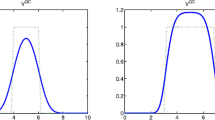Abstract
We consider quantum mechanics written in hydrodynamic formulation for the case of relativistic spinor fields to study their velocity: within such a hydrodynamic formulation it is possible to see that the velocity as is usually defined can not actually represent the tangent vector to the trajectories of particles. We propose an alternative definition for this tangent vector and hence for the trajectories of particles, which we believe to be new and the only one possible. We discuss how these results are a necessary step to take in order to face further problems, like the definition of trajectories for multi-particle systems or ensembles, as they happen to be useful in many applications and interpretations of quantum mechanics.
Similar content being viewed by others
References
Pusey, M.F., Barrett, J., Rudolph, T.: On the reality of the quantum state. Nat. Phys. 8, 476 (2012)
Schrödinger, E.: Die gegenwärtige Situation in der Quantenmechanik. Naturwissenschaften 23, 807 (1935)
Einstein, A., Podolsky, B., Rosen, N.: Can quantum-mechanical description of physical reality be considered complete? Phys. Rev. 47, 777 (1935)
Bohm, D., Aharonov, Y.: Discussion of experimental proof for the paradox of Einstein, Rosen, and Podolsky. Phys. Rev. 108, 1070 (1957)
Bell, J.S.: On the problem of hidden variables in quantum mechanics. Rev. Mod. Phys. 38, 447 (1966)
John Stewart Bell: On the Einstein Podolsky Rosen paradox. Phys. Phys. Fizika 1, 195 (1964)
Clauser, J.F., Horne, M.A., Shimony, A., Holt, R.A.: Proposed experiment to test local hidden variable theories. Phys. Rev. Lett. 23, 880 (1969)
Kochen, S., Specker, E.: The Problem of Hidden Variables in Quantum Mechanics. J. Math. Mech. 17, 59 (1968)
Cabello, A.: Interpretations of Quantum Theory: A Map of Madness–In Information and Quantum Mechanics. Cambridge University Press, Cambridge (2017)
de Broglie, L.: La mécanique ondulatoire et la structure atomique de la matière et du rayonnement. J. Phys. Radium 8, 225 (1927)
de Broglie, L.: Sur l’introduction des idées d’onde-pilote et de double solution dans la théorie de l’électron de Dirac. C. R. Acad. Sci. 235, 557 (1952)
Vigier, J.P.: Forces s’exerçant sur les lignes de courant usuelles des particules de spin \(0\), \(1/2\) et \(1\) en théorie de l’onde pilote. C. R. Acad. Sci. 235, 1107 (1952)
Vigier, J.P.: Structures des micro-objets dans l’interpretation causale de la théorie des quanta. Ph.D. Thesis (1956)
Bohm, D.: A suggested interpretation of the quantum theory in terms of ‘Hidden’ Variables. Phys. Rev. 85, 166 (1952)
Takabayasi, Takehiko: On the formulation of quantum mechanics associated with classical pictures. Prog. Theor. Phys. 8, 143 (1952)
Bohm, D.: Comments on an article of Takabayasi concerning l. Prog. Theor. Phys. 9, 273 (1953)
Bohm, D., Schiller, R., Tiomno, J.: A causal interpretation of the Pauli equation (A and B). Nuovo Cimento 1, 48 and 67 (1955)
Takabayasi, T.: On the hydrodynamical representation of non-relativistic spinor equation. Prog. Theor. Phys. 12, 810 (1954)
Holland, P.R.: The Dirac equation in the de Broglie-Bohm theory of motion. Found. Phys. 22, 1287 (1992)
Dürr, D., Munch-Berndl, K.: A hypersurface Bohm-Dirac theory. Phys. Rev. A 60, 2729 (1999)
Dürr, D., Goldstein, S., Norsen, T., Struyve, W., Zanghì, N.: Can Bohmian mechanics be made relativistic? Proc. R. Soc. Lond. A 470, 20130699 (2013)
Yvon, J.: Équations de Dirac-Madelung. J. Phys. Radium 1, 18 (1940)
Takabayasi, T.: Relativistic hydrodynamics equivalent to the Dirac equation. Prog. Theor. Phys. 13, 222 (1955)
Takabayasi, T.: Hydrodynamical description of the Dirac equation. Nuovo Cimento 3, 233 (1956)
Takabayasi, T.: Relativistic hydrodynamics of the dirac matter. Prog. Theor. Phys. Supplement 4, 1 (1957)
Jakobi, G., Lochak, G.: Introduction des paramètres relativistes de Cayley-Klein dans la représentation hydrodynamique de l’équation de Dirac. C. R. Acad. Sci. 243, 234 (1956)
Jakobi, G., Lochak, G.: Decomposition en paramètres de Clebsch de l’impulsion de Dirac et interprétation physique de l’invariance de jauge des équations de la Mécanique ondulatoire. C. R. Acad. Sci. 243, 357 (1956)
Fabbri, L.: Spinors in polar form. Eur. Phys. J. Plus 136, 354 (2021)
Fabbri, L.: de Broglie-Bohm formulation of Dirac fields. Found. Phys. 52, 116 (2022)
Holland, Peter R.: The Quantum Theory of Motion. Cambridge University Press, Cambridge (1993)
Tumulka, R.: Foundations of Quantum Mechanics. Springer, Cham (2022)
Drezet, A.: Justifying Born’s rule \(P_{\alpha }=|\Psi _{\alpha }|^{2}\) using deterministic chaos, decoherence, and the de Broglie-Bohm quantum theory. Entropy 23, 1371 (2021)
Drezet, A.: Making sense of Born’s rule \(p_{\alpha }=|\!|\Psi _{\alpha }|\!|^{2}\) with the many-minds interpretation. Quant. Stud. Math. Found. 8, 315 (2021)
Drezet, A.: Forewords for the special issue ‘Pilot-wave and beyond: Louis de Broglie and David Bohm’s quest for a quantum ontology’. Foundations of Physics (2022)
Holland, P.: Uniqueness of paths in quantum mechanics. Phys. Rev. A 60, 4326 (1999)
Fabbri, L.: Geometry, Zitterbewegung, Quantization. Int. J. Geom. Meth. Mod. Phys. 16, 1950146 (2019)
Gondran, M., Gondran, A.: Replacing the singlet spinor of the EPR-B experiment in the configuration space with two single-particle spinors in physical space. Found. Phys. 46, 1109 (2016)
Bohm, D., Hiley, B.J.: The Undivided Universe: An Ontological Interpretation of Quantum Theory. Routledge, London (1993)
Funding
This research received no funding.
Author information
Authors and Affiliations
Contributions
Luca Fabbri did all computations, wrote the main manuscript and reviewed the final version.
Corresponding author
Ethics declarations
Conflict of interest
The author declares no conflict of interest.
Additional information
Publisher's Note
Springer Nature remains neutral with regard to jurisdictional claims in published maps and institutional affiliations.
Rights and permissions
Springer Nature or its licensor (e.g. a society or other partner) holds exclusive rights to this article under a publishing agreement with the author(s) or other rightsholder(s); author self-archiving of the accepted manuscript version of this article is solely governed by the terms of such publishing agreement and applicable law.
About this article
Cite this article
Fabbri, L. Dirac Theory in Hydrodynamic Form. Found Phys 53, 54 (2023). https://doi.org/10.1007/s10701-023-00695-w
Received:
Accepted:
Published:
DOI: https://doi.org/10.1007/s10701-023-00695-w




